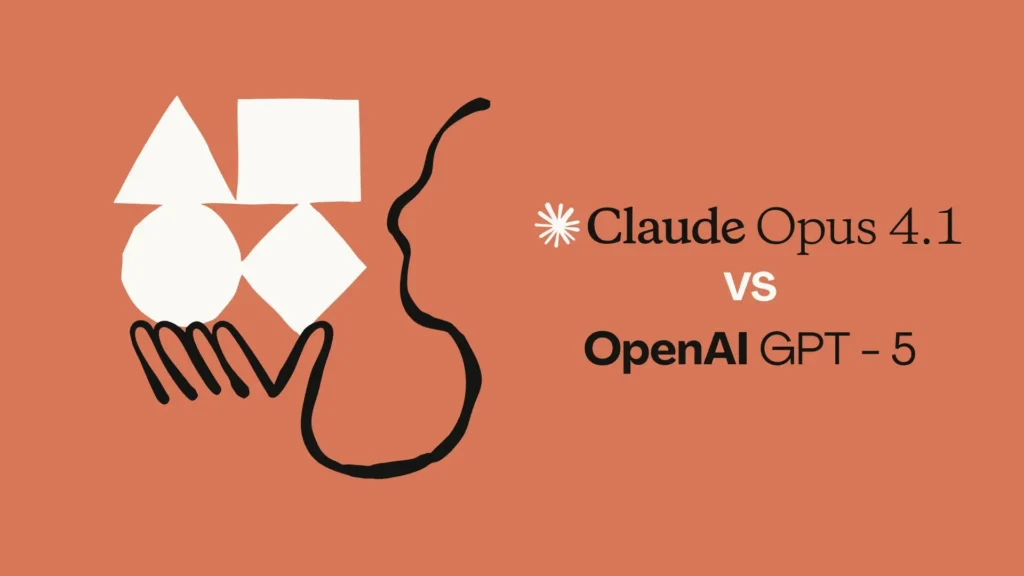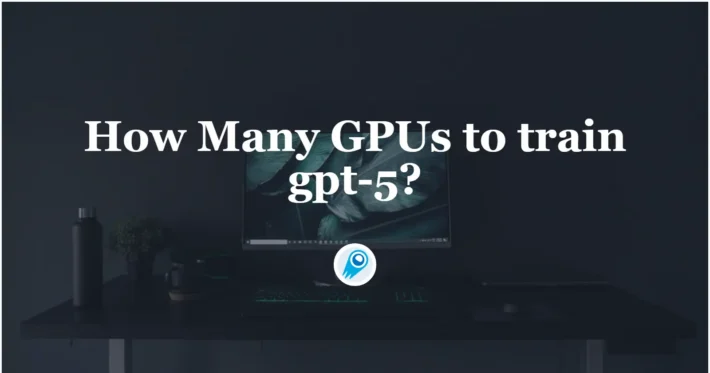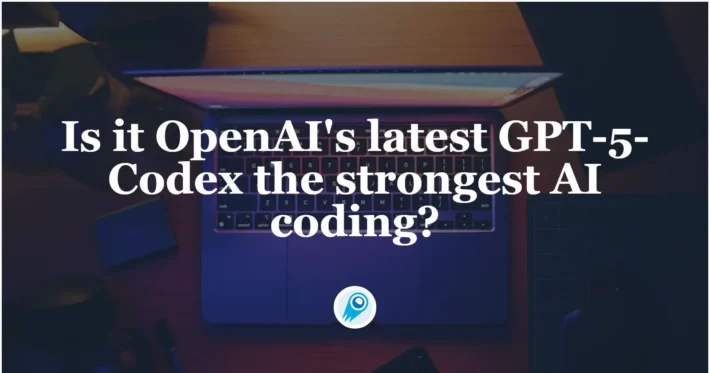OpenAI’s GPT-5 vs Claude Opus 4.1: A coding comparison

Anthropic’s Claude Opus line (Opus 4 / Claude Opus 4.1) and OpenAI’s GPT-5 show state-of-the-art performance on modern coding benchmarks, but they trade strengths: Opus emphasizes long-context, multi-step agentic workflows while GPT-5 focuses on front-end polish, developer ergonomics and broad product integrations. The best choice depends on the tasks you need automated (single-file generation vs. multi-file refactor), your cost/throughput constraints, and how you’ll measure “success” (passing unit tests, runtime correctness, or human review overhead).
Why this question matters now
Both vendors shipped major releases in early August 2025: Anthropic announced Claude Opus 4.1 (Aug 5, 2025) as an iterative improvement focused on agentic tasks and “real-world coding,” and OpenAI published GPT-5 (system card and developer materials released in the same early August window) with explicit claims of being their “strongest coding model to date.” Those near-simultaneous launches mean developers and platform teams are actively comparing performance, costs, and integration paths — so this isn’t academic: teams are choosing which model to route Copilot-style suggestions to, which model to deploy behind internal code agents, and which to trust for security-sensitive automation.
What is Claude Opus 4.1?
Anthropic positioned Opus 4.1 as a targeted upgrade to Opus 4, emphasizing better performance on agentic and real-world coding tasks. They said Opus 4.1 is available to paid Claude users and in Claude Code, and that it’s been rolled into partner platforms (API, Bedrock, Vertex). Anthropic’s messaging stresses reliability on multi-step logic, precision in code outputs, and safer agent behavior.
Claude Opus 4.1 – Architecture & Encoding Features
- Extended Context & Long-Horizon Reasoning: Equipped with a c. 200K token context window, significantly enhancing its ability to maintain coherence across lengthy workflows and multi-file codebases.
- Higher SWE-bench Verified Performance: Achieved 74.5% accuracy on SWE-bench Verified (up from 72.5% in Opus 4), along with notable improvements in agentic tasks (39.2% to 43.3%) and reasoning (79.6% to 80.9%).
- Refinement via Chain-of-Thought & RLHF: Retains Opus 4’s architectural backbone while enhancing chain-of-thought reasoning, multi-step coherence, and attention to detail through RLHF and data-driven tuning.
- Agentic Workflow Integration: Designed to orchestrate multi-step workflows, including complex code refactoring and agentic tool usage, while preserving internal state over extended sessions.
- Enhanced Tooling & Creative Control: Offers “thinking summaries” that condense the model’s internal reasoning, improving transparency. Opus 4.1 also integrates better with developer tooling via Claude Code, API chaining, and files-access capabilities.
What is GPT-5?
OpenAI’s public materials describe GPT-5 as the strongest coding model they’ve produced, and they published benchmark results (SWE-bench Verified and others) showing material improvements over prior models. OpenAI’s messaging highlights GPT-5’s ability to handle complex frontend generation, debugging of larger repositories, and improved efficiency in tool usage. The accompanying system card outlines model composition (fast model + deeper reasoning model).
GPT-5 – Architecture & Encoding Features
- Dynamic Router & Dual Processing Modes: Built as a unified system combining fast-response and deep-reasoning pathways. A router dynamically routes queries to either rapid generation or extended “thinking” mode, enhancing efficiency for both simple and complex tasks.
- Massive Context Window: Supports up to 256K tokens of context, enabling it to handle extensive inputs like large codebases, long-form documents, and multi-session projects without losing coherence.
- Multimodal Understanding & Memory: Natively processes text, images, audio, and video within a single session. Includes persistent memory and personalization features that enhance continuity across long-term interactions.
- Enhanced Safety & Honest Reasoning: Introduces “safe completions” that balance helpfulness with clear acknowledgment of limitations. In reasoning mode, GPT-5 dramatically reduces hallucination and deception—dropping deceptive output from ~86% to ~9% in certain tests.
- Reasoning & Verbosity Controls: Developers can adjust
reasoning_effort(minimal/low/high) andverbosity(low/medium/high), controlling output depth and detail. Also supports structured output formatting via regex or grammar constraints.
What do the hard numbers say — benchmark scores, context windows and token pricing?
Benchmarks and percentages
- SWE-bench (Verified): Anthropic reports Claude Opus 4.1: 74.5% on SWE-bench Verified. OpenAI reports GPT-5: 74.9% on the same benchmark (and 88% on some polyglot benchmarks). These numbers place both models within a tight band on realistic coding task suites. Benchmarks show parity at the top end, with tiny numeric differences that rarely map cleanly to real-world productivity.
Context windows (why it matters)
GPT-5’s official maximum combined context (input + output) is 400,000 tokens, with the API allowing up to ~272,000 input tokens and up to 128,000 output tokens (those two together make the 400k total). In ChatGPT,The free version gives you access to the main GPT-5 model as well as GPT-5 Thinking, but with the smallest context window and tighter usage limits. Subscribers get the same models, but with expanded scope and a larger context window of 32K tokens. The Pro version is where it all starts. You get GPT-5, GPT-5 Thinking, and GPT-5 Pro—the latter a high-end version designed for maximum reasoning depth and accuracy. The context window jumps to 128K tokens. Enterprise users also get a 128K context window, while Teams are limited to 32K.
Claude Opus 4.1 (context window). Anthropic’s Claude Opus 4.1 is shipped as a hybrid reasoning model with a ~200,000-token context window in its product documentation, and it is explicitly optimized for long-horizon, multi-step reasoning and agentic coding workflows. That 200K window enables Opus 4.1 to keep a large portion of a repository, tests, and design notes in a single context—helpful for multi-file refactors, migration tasks, and chained tool interactions where sustaining internal state and chain-of-thought across many steps matters more than the lowest possible latency.
Pricing (input / output cost examples)
- OpenAI (GPT-5) published example pricing lines such as Input \$1.25 / 1M tokens, Output \$10 / 1M tokens for standard GPT-5 variants and lower tiers (mini/nano) at lower unit cost. These numbers are useful to estimate large CI workflows.
- Anthropic (Opus 4.1) shows higher unit costs in some published pages (example: \$15 / 1M input tokens and \$75 / 1M output tokens on a quoted page — but Anthropic also advertises prompt caching, batching and other cost-saving levers). Always check vendor pricing pages for the plan you’ll use.
Implication: at scale, token pricing + output verbosity (how many tokens the model emits) matters a lot. A model that writes more tokens or needs more iterative passes ends up costing more even if per-token rates are lower.
How do their strengths map to real developer tasks?
Single-file generation, prototyping and UI code
GPT-5 is repeatedly highlighted for producing polished UI/UX code (HTML/CSS/JS) and clean single-file implementations quickly. This maps well to front-end scaffolding, prototyping, and “generate-then-human-polish” workflows. GPT-5 marketing and early community tests emphasize design choices, spacing, and front-end aesthetic quality.
Multi-file refactors, long reasoning, and agentic workflows
Anthropic pitches Claude (Opus) for sustained multi-step reasoning and agentic tasks — things like large refactors, multi-file API migrations, and automated code orchestration where the assistant needs to reason across many files and preserve invariants. Opus 4.1 explicitly claims improvements for multi-step code tasks and agentic integrations. These strengths translate to fewer catastrophic context losses when reasoning over tens of thousands of tokens.
How do their encoding choices affect accuracy, hallucinations, and debugging?
Fidelity vs. hallucination tradeoffs: Anthropic has publicly positioned Claude models to be conservative and instruction-aligned (reducing certain classes of hallucination), which is part of why Opus 4.1 emphasizes “detail tracking” and rule adherence. OpenAI’s GPT-5 aims to be both fast and more reliable across a broad range of tasks, relying on system-level routing and dedicated safety/mitigation described in its system card. Both vendors still acknowledge residual hallucination risk and provide mitigation guidance.
Debugging and iterative repair: Encoding more of the repo + test outputs in one prompt reduces context switching and lets the model propose fixes that take broader project state into account. Opus 4.1 advertises a strength in following multi-step debug instructions; GPT-5 advertises fast, design-aware front-end generation and richer tool integrations. Both improve iterative debugging, but neither removes the need for human test verification and code review.
Feature Comparison Table
| Feature | GPT-5 (OpenAI) | Claude Opus 4.1 (Anthropic) |
|---|---|---|
| Release | August 2025 | August 5, 2025 |
| Context Window | Up to 400K tokens (long documents, codebases) | ~200K tokens, optimized for multi-step, long workflows |
| Processing Modes | Dual-mode (fast vs deep “reasoning”), with routing | Long-form chain-of-thought and sustained reasoning |
| Multimodal Support | Text, image, audio, video; persistent memory | Primarily text (improved reasoning and creative flow) |
| Coding & Benchmarks | 74.9% SWE-bench Verified, 88% on Aider Polyglot | 74.5% SWE-bench Verified; strong multi-file refactoring |
| Safety & Reliability | Reduced hallucination, safe completions, honest output | Conservative behavior; improved correctness and safety |
| Control & Tooling | reasoning_effort, verbosity, structured outputs | Thinking summaries, tool integration via Claude Code SDK |
How to measure which is better for your codebase — practical evaluation plan (with code)
Below is a practical, reproducible harness you can run to compare Claude Opus 4.1 and GPT-5 on your repository. The harness automates: (1) prompt the models to implement or fix a function, (2) insert the output into a sandboxed file, (3) run unit tests, and (4) record pass/fail, token usage and iteration count.
Warning: executing generated code is powerful but risky — always run sandboxed containers, use resource/time limits, and never allow generated code to access sensitive secrets or network unless intentionally permitted and audited.
1) What the harness measures
- Unit test pass rate (primary).
- Number of edit cycles (how many times you needed to ask for fixes).
- Tokens consumed (input + output).
- Wall-clock latency.
2) Example Python harness (skeleton)
You can use CometAPI for testing,By offering consistent authentication, request formatting, and response handling, CometAPI dramatically simplifies the integration of AI capabilities into your applications.
CometAPI offers “one API” access to 500+ models and documents an OpenAI-compatible interface that you can call with a CometAPI API key and a base URL override; this makes switching from a direct OpenAI client easy Instead of integrating Anthropic and switching between openAI. For Claude Opus 4.1, CometAPI exposes specific model identifiers (for example claude-opus-4-1-20250805 and a thinking variant) and a dedicated chat completions endpoint.For GPT-5, CometAPI exposes specific model gpt-5gpt-5-2025-08-07” / “gpt-5-chat-latest. To begin, explore the model’s capabilities in the Playground and consult the API guide for detailed instructions.
python"""
side_by_side_eval.py
High-level harness:
- tasks: list of dicts {name, prompt, test_file_contents}
- apis: simple wrappers for OpenAI (GPT-5) and Anthropic (Claude Opus 4.1)
- run: for each task, call each model, write code, run pytest, collect metrics
NOTE: replace API_KEY_* with your keys and confirm official endpoints/params per vendor docs.
"""
import os
import json
import subprocess
import time
from typing import Dict, Any
import requests
# === CONFIG - fill these from your environment ===
# === Simple API wrappers (check vendor docs for exact endpoints/params) ===
def call_gpt5(prompt: str, max_tokens=1024) -> Dict[str, Any]:
url = "https://api.cometapi.com/v1/responses" # example; confirm actual endpoint headers = {"Authorization": f"Bearer {CometAPI_API_KEY}"}
body = {
"model": "gpt-5",
"input": prompt,
"max_output_tokens": max_tokens
}
t0 = time.time()
r = requests.post(url, headers=headers, json=body, timeout=60)
latency = time.time() - t0
r.raise_for_status()
resp = r.json()
# token info might be in resp['usage'] depending on API; adapt as needed
return {"text": resp["output_text"] if "output_text" in resp else resp, "raw": resp, "latency": latency}
def call_claude(prompt: str, max_tokens=1024) -> Dict[str, Any]:
url = "https://api.cometapi.com/v1/chat/completions" # example; confirm actual endpoint headers = {"x-api-key": CometAPI_API_KEY}
body = {
"model": "claude-opus-4-1-20250805", "prompt": prompt,
"max_tokens_to_sample": max_tokens
}
t0 = time.time()
r = requests.post(url, headers=headers, json=body, timeout=60)
latency = time.time() - t0
r.raise_for_status()
resp = r.json()
return {"text": resp.get("completion", ""), "raw": resp, "latency": latency}
# === Test runner ===
def run_task(task: Dict[str, Any], model_fn, model_name: str):
"""Run a single task: call model, write file, run pytest, collect result."""
prompt = task["prompt"]
result = model_fn(prompt, max_tokens=task.get("max_tokens", 2048))
code_text = result["text"]
# write task files into temporary folder
tmpdir = f"runs/{task['name']}/{model_name}"
os.makedirs(tmpdir, exist_ok=True)
code_file = os.path.join(tmpdir, "submission.py")
with open(code_file, "w") as f:
f.write(code_text)
# write tests
test_file = os.path.join(tmpdir, "test_submission.py")
with open(test_file, "w") as f:
f.write(task["test_code"])
# run pytest in subprocess with timeout
try:
proc = subprocess.run(
["pytest", "-q", "--disable-warnings", tmpdir],
stdout=subprocess.PIPE, stderr=subprocess.STDOUT,
timeout=30
)
passed = proc.returncode == 0
output = proc.stdout.decode()[:2000]
except subprocess.TimeoutExpired:
passed = False
output = "pytest timeout"
return {
"model": model_name,
"task": task["name"],
"passed": passed,
"latency": result["latency"],
"tokens_estimate": result["raw"].get("usage", {}),
"stdout": output,
"code": code_text
}
# === Example tasks: simple function to implement ===
TASKS = [
{
"name": "is_prime",
"prompt": "Implement a Python function `is_prime(n: int) -> bool` with proper docstring and edge case handling.",
"test_code": """
import submission
def test_prime():
assert submission.is_prime(2)
assert submission.is_prime(13)
assert not submission.is_prime(1)
assert not submission.is_prime(0)
assert not submission.is_prime(-7)
assert not submission.is_prime(15)
""",
"max_tokens": 256
}
]
# === Runner ===
if __name__ == "__main__":
results = []
for task in TASKS:
for model_fn, name in [(call_gpt5, "gpt-5"), (call_claude, "claude-opus-4.1")]:
res = run_task(task, model_fn, name)
print(json.dumps(res, indent=2))
results.append(res)
# save to file
with open("results.json", "w") as f:
json.dump(results, f, indent=2)
To simulate multi-file refactors, include tasks where the prompt contains multiple files (or feed repository slices via retrieval). For long contexts, measure whether the model needs retrieval vs. in-prompt context.
What metrics should you report and why?
- Unit test pass rate (binary per task) — primary, objective.
- Human correction time — how long a developer must edit before tests pass.
- Iterations to pass — how many prompt/feedback rounds were necessary.
- Tokens consumed — cost proxy (input + output).
- Wall-clock latency — matters for interactive use.
- Security & API misuse patterns — e.g., whether generated code uses unsafe eval/network calls.
Collect these per task and aggregate (mean pass rate, median tokens, P95 latency). That will give a practical picture of cost vs. value.
Final Thoughts
- GPT-5 stands out with its multimodal flexibility, massive context handling, adaptive reasoning dynamics, detailed developer controls, and improved safety. It’s ideal for contexts that involve varied data types, long project continuity, fast prototyping, and interactive agentic tasks.
- Claude Opus 4.1 leans into deep, multi-step reasoning, remarkable consistency across lengthy sequences, and refined performance on coding benchmarks. Its enhancements in chain-of-thought and tooling make it an excellent choice for complex codebase transformations and agentic developer workflows.
Your best path may be combining both: use GPT-5 for rich, interactive multimodal tasks and rapid prototyping, and rely on Claude Opus 4.1 for deeply structured reasoning, multi-file refactors, and high-fidelity code operations.



